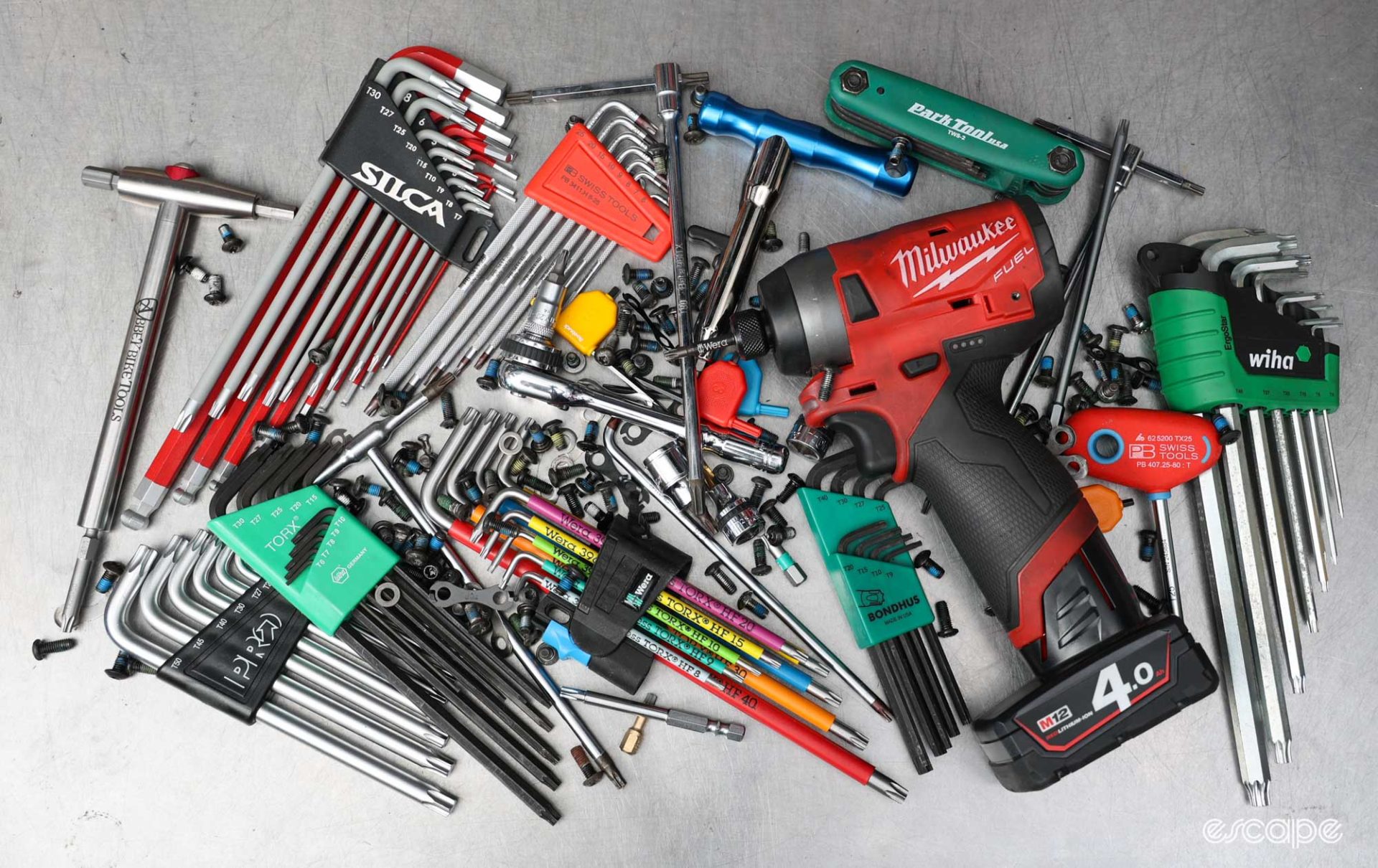Torx gets a bad wrap in the cycling world, and that should come as little surprise given we’re talking about the common combination of poor quality and shallow fasteners mixed with often equally crummy tools. So in this second instalment of Threaded, I’ll be offering solutions to avoid the dreaded “oh crap” moment of camming out (or rounding) a shallow Torx fastener.
There is also TorxPlus more (you’ll come to understand this joke shortly).
Welcome to Threaded, an ongoing series for tool nerds, DIYers, and professional mechanics. If you haven’t already, you can sign up for free to ensure you don’t miss future editions.
Torx explained

So how did we get here? Created in the 1960s by USA industrial conglomerate Textron Inc, Torx is a six-point star-shaped pattern that introduced improved tool and fastener head durability in manufacturing assembly (along with providing a tamper-proof shape). In the past few decades, Torx (aka Hexalobular or Star Drive if you’re avoiding the Torx Trademark) has found increasingly widespread use across multiple industries, and when compared with hex, it offers greater surface contact and tool engagement, meaning more torque capacity for a given size fastener head.
In bicycle applications, Torx made its first mainstream appearance in disc brake rotor bolts by meeting the demand for having a low-profile (button head) fastener that could reliably handle a suitable torque. Since then, almost all major cycling component brands have used Torx in places of shallower and/or lighter aluminium or titanium fasteners.
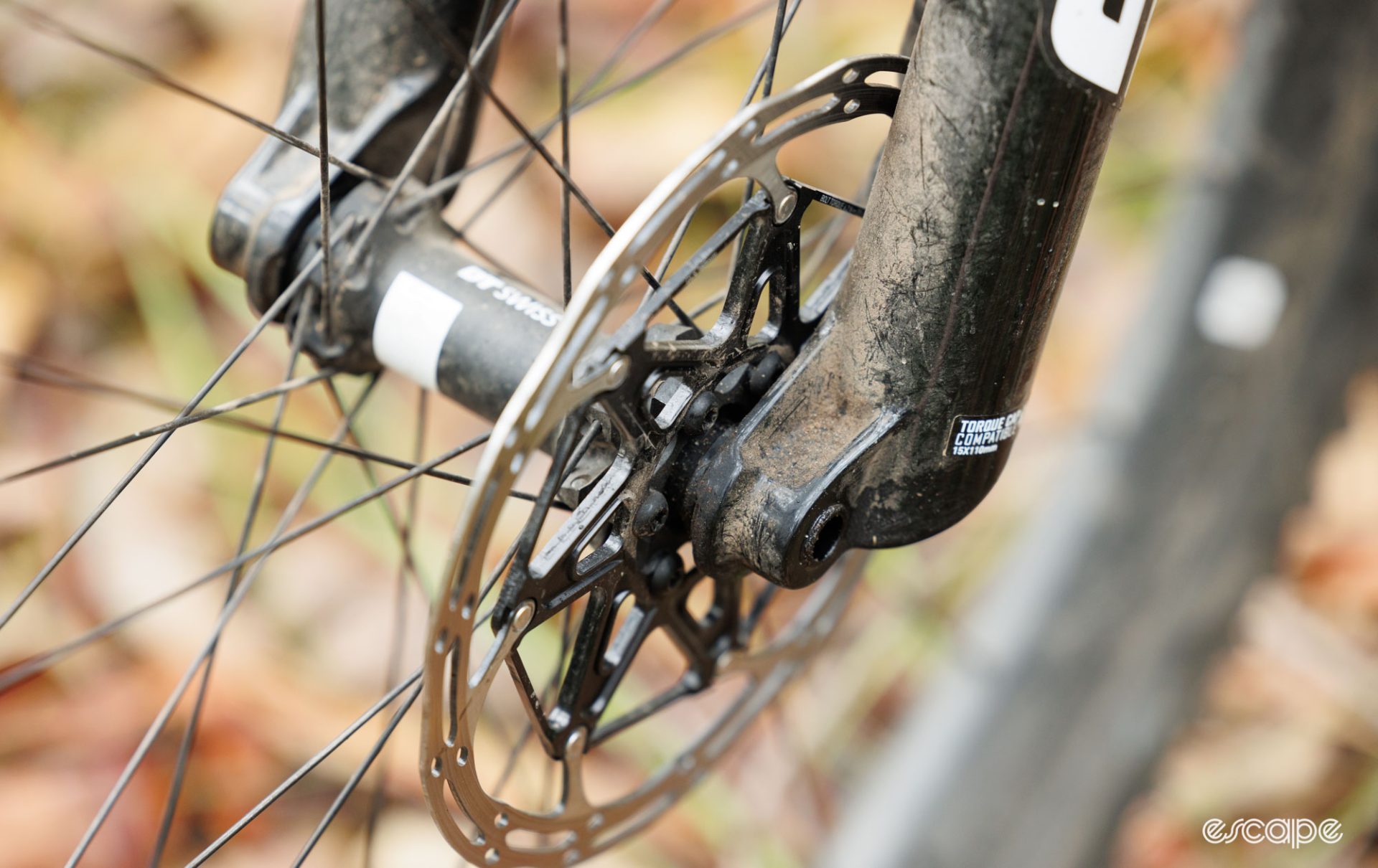
Unfortunately, such shallow designs only allow for minimal depth insertion of the tool. Meanwhile, those lighter materials are often softer, too. Add in wishy-washy tolerances, and you have an easy do-it-yourself recipe for ruined fastener heads.
Better technique
If you’re stripping Torx heads then the answer is better tools and a change of technique. Or in some cases (looking at you SRAM Flat Mount caliper bolts), a change to deeper bolt heads is my preferred long-term approach. Obviously, I’ll get to the tools, but let’s first talk technique.
It may sound dumb, but it’s important to figure out whether you need a Torx or Hex tool. Some sizes of hex tools will engage with some Torx bolts (some bolts are even designed to work with either tool). A flashlight can be a useful diagnostic tool for identifying subtle shape differences.
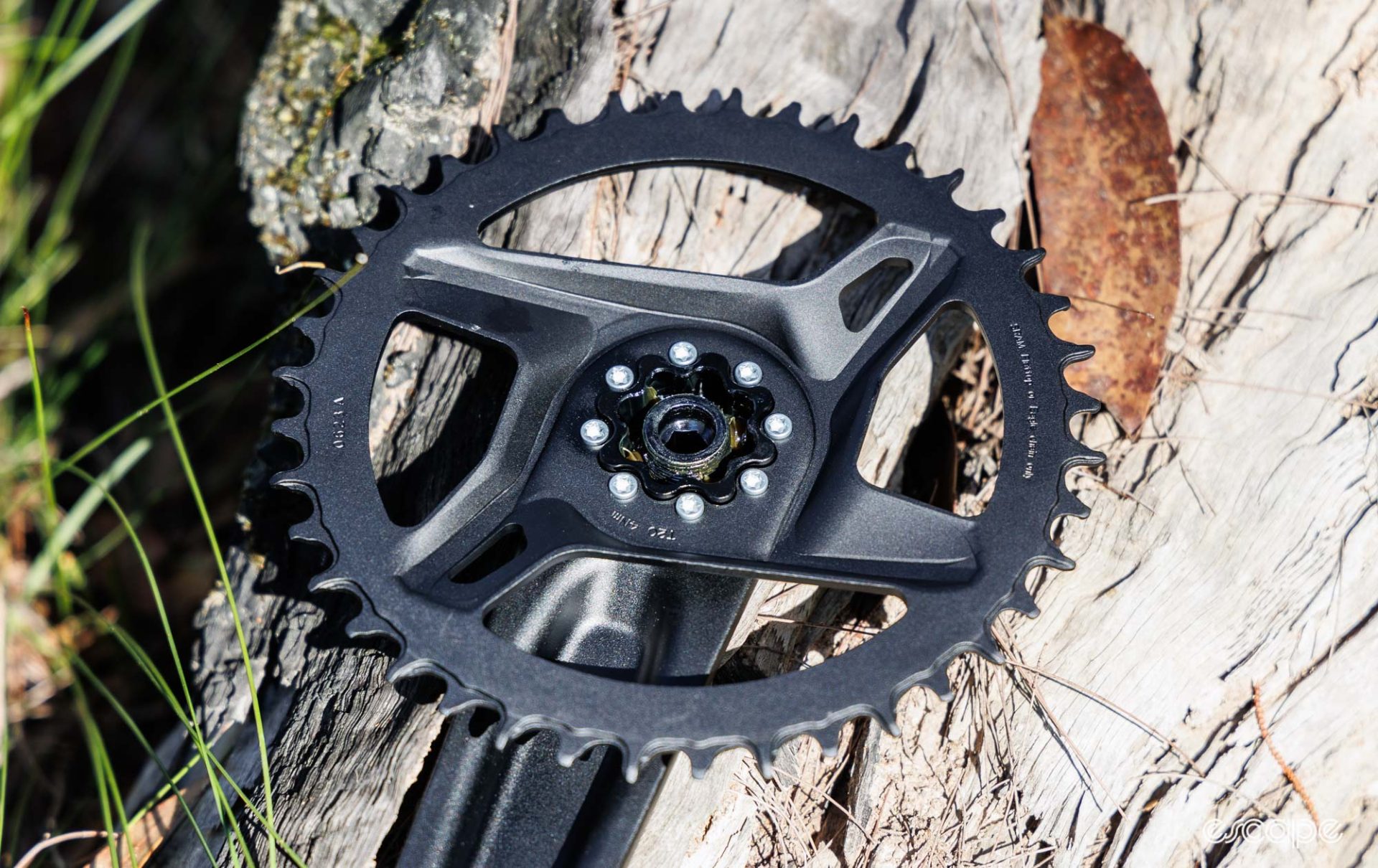
If you’ve identified it’s a star drive, you then need to work out the size. Unlike hex, Torx is surprisingly easy to mess up in this regard. A T10 driver will get a T15 fastener moving, and likewise for a T25 tool in a rarer T27 fastener (stripped an XTR M9000 chainring bolt? Yeah … those were T27). If you’re unsure, try multiple sizes and pick the one with the tightest fit.
With any shallow or easily rounded fastener you want to ensure the inside cavity of the fastener is clean of debris. Anything that prevents the tool from sitting squarely will be problematic.
Finally, how you apply the torque matters a whole lot. You want a perpendicular path between the fastener head and your torque application. Similarly, you want to apply pressure into the fastener as you turn it – this is the same technique as using a Philips screwdriver and it’ll help prevent the tool from camming out due to out-of-plane torque.
The tighter or shallower a fastener, the more this all matters. To an experienced mechanic all of this is second nature, but it requires ongoing thought for the occasional tinkerer.
Use quality tools
The skins of my “buy better-quality tools” drum are pretty tattered by this point, but this approach holds wholly true for Torx. Cheap Torx tools consistently seem to cause more ruined bolts (and days) than great tools.
I did some rudimentary torque output testing between a generic mid-range “S2” Torx T25 bit and a PB Swiss TX25 bit. Using new T25 rotor bolts from the same batch, the generic bit twisted off and ruined the bolt at 8.8 Nm, while the PB Swiss beat my rudimentary test (by stripping the fixture threads) at 14.9 Nm.
While lesser Torx tools will wear or break more readily, they’re also typically less precise-fitting, something easily felt as angular and rotational movement between the tool and the fastener. Here, I measured that a USA-made Bondhus L-shaped T25 key could pivot within the fastener by 10°, while a PB Swiss L-shaped T25 tool had a maximum angular wiggle of 6°. More angular movement means a looser fit and a tool that’s more likely to cam-off, while less movement means better engagement. Neither of these are extreme examples either, with a USAG T-handle proving to have the most angular movement (more than 15°) of those tested, and a Wera Stainless L-key the least (less than 4°). You can see these in action on my Instagram.
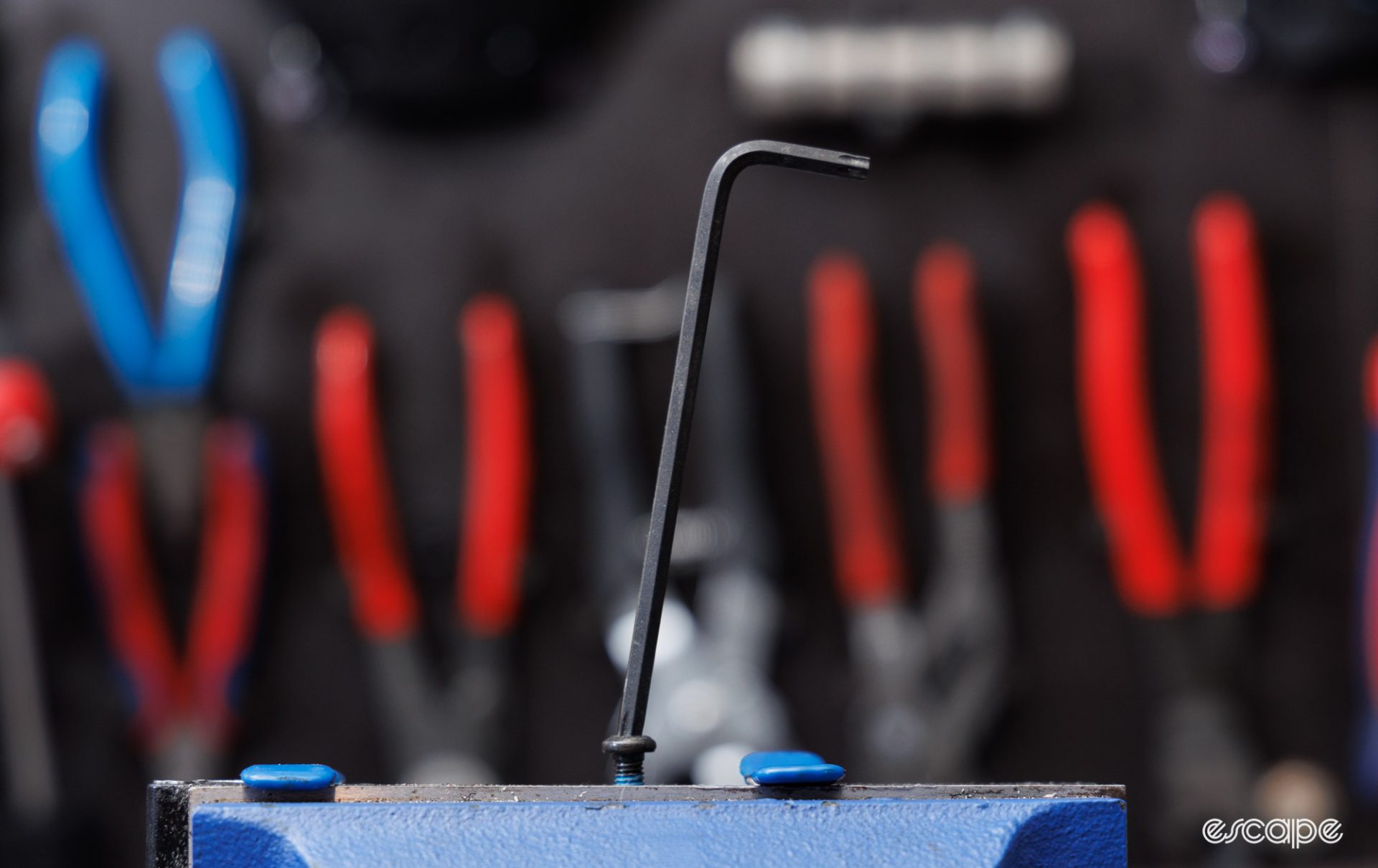
To cut to the chase, I’ve had consistently great experiences with Torx tools from Wera, PB Swiss, and Wiha. Other brands can be far more hit-and-miss. For example, the Taiwanese-made T-handles from Park Tool offer a decent fitment, but the company’s P-handles and sockets typically don’t. Snap-On’s bit sockets are wonderful, but some of its other Torx tools have had disappointing sizing. And between the Japanese socket kings, Koken’s Torx bit sockets are typically great, while Nepros’ even fancier-looking Torx sockets tend to fit more loosely.
Just like hex tools, the smaller the fastener size, the more critical a good fitment becomes. You can typically get away with a looser-fitting tool in a T30 chainring bolt, but not so much for a shallow T25 fastener. Regardless of size, I strongly suggest skipping ball-ended Torx tools for bicycle applications.
To complicate matters further, you have some component brands purposefully solving for the common use of crummy tools by undersizing fasteners. Zipp notoriously does this with its stem bolts, and as a result, my preferred PB Swiss T25 bit is too big while the tapered splines on Wera’s HF (Holding Function) tools stop full-depth insertion. Thankfully this issue is relatively rare.
If your eyes are glazing over then you probably don’t work with Torx on a daily basis. If that’s you, then it’s worth knowing that for bicycle applications, sizes ranging from T6 to T40 are used by relatively big brands, while sizes T8, T10, T15, T20, T25, and T30 are the most commonly found in cycling. If you just want one set to cover most potential Torx needs on a bicycle, I’d suggest buying an L-shaped set from Wera (#967/9) or Wiha (#36698).
Unfortunately, my holy grail would either be a set of PB Swiss that spans from T6-T30, or a standard Wera set without either a ball-end or the Holding Function (HF) – neither of which currently exist. One day…
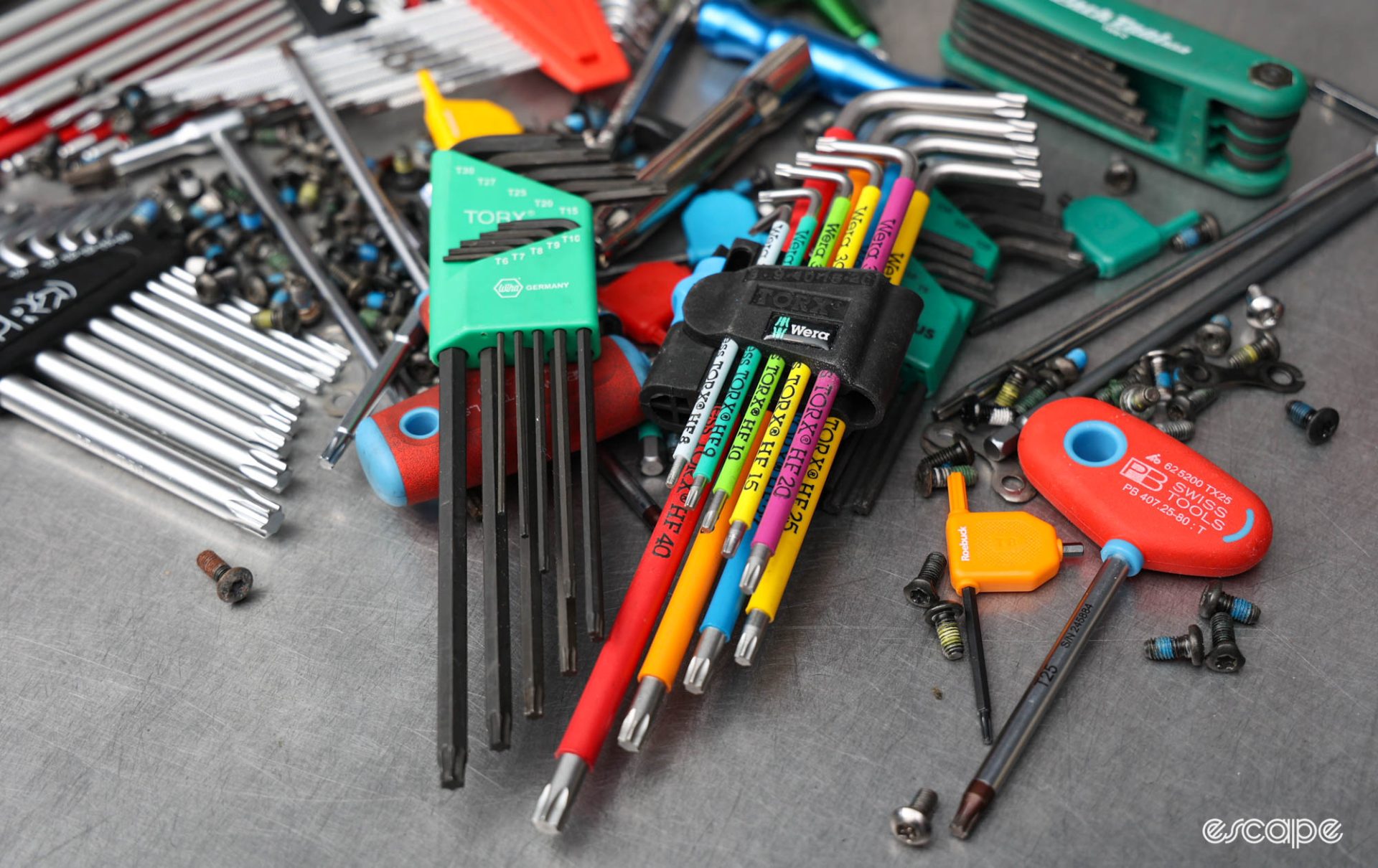
What I use
While my list of the 4 mm hex keys I use is long, you’ll be pleased (or perhaps disappointed?) to know my list of Torx tools in regular use is quite a bit shorter. Here are my go-to T25 tools.
My most faithful is the PB Swiss 1407 P-handle. I wouldn’t say I like this tool style in an equivalent 4 mm hex size, but I find that Torx on bicycles is often in more easily accessible spots which means the larger P-handle is less of an issue. This driver allows me to comfortably apply that all-important downward pressure on the fastener as it is turned. Add in great durability and a secure fit, and there’s a lot to like in this one.
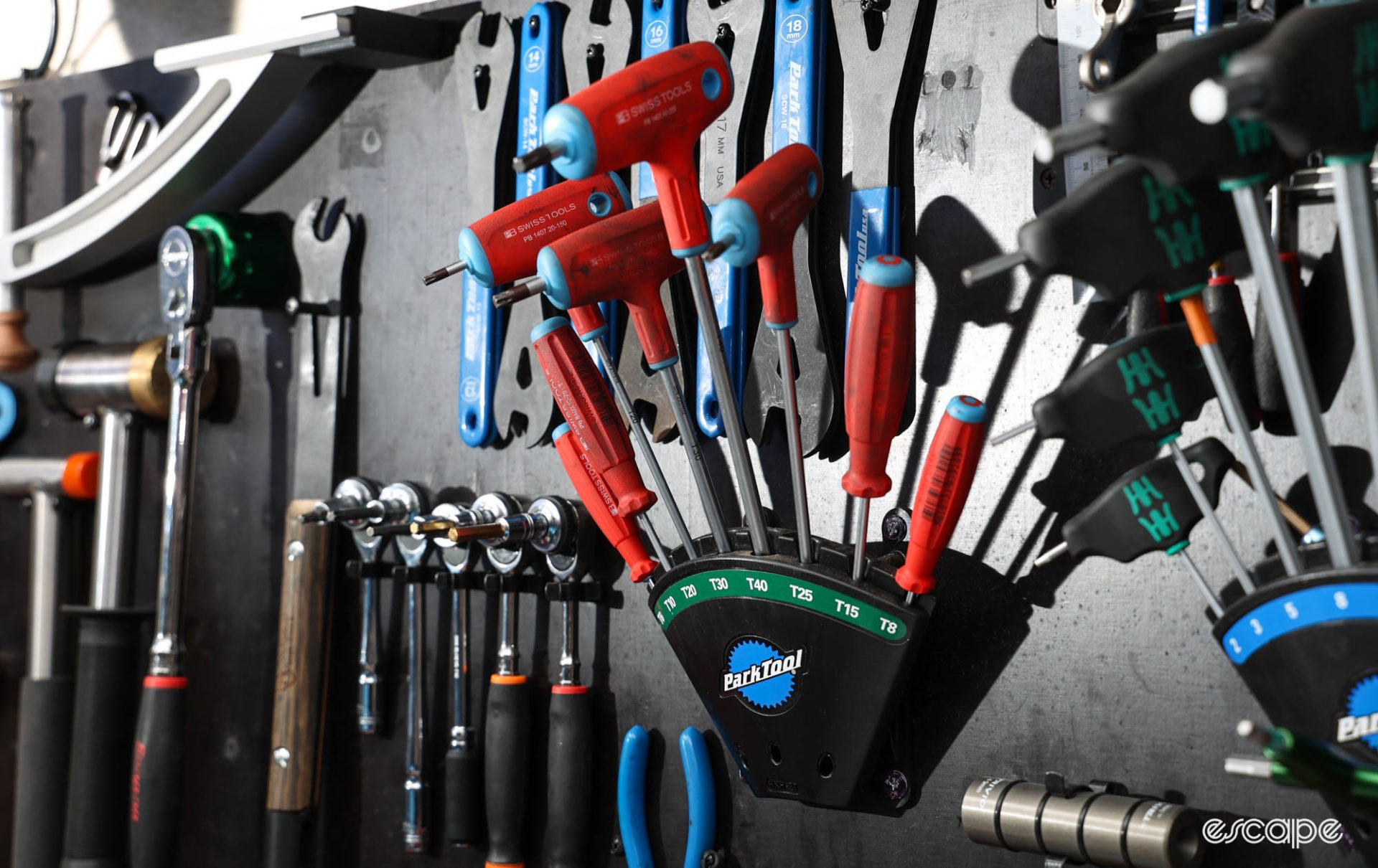
Next on the list is a ratchet combination almost identical to that from my 4 mm hex list. Here I combine a Nepros 1/4″ ratchet (short handle), a Nepros thumb spinner, and a Koken Zeal bit socket. This bit socket isn’t as tight-fitting as a Wera or PB Swiss, but as a result, it fits into everything. Given this, I avoid using this tool for suspected stuck bolts, and rather I use it on deeper-headed fasteners or lower-torque applications such as derailleurs, stem bolts, seatpost bolts, and bidon cage bolts.
Anytime I have rotor bolts I’m immediately reaching for my trusty Milwaukee M12 Fuel Impact driver with a Wera Impaktor T25 bit. Compared to an electric drill, an impact driver adds a directional hammer effect, so I can focus on applying a downward load into the bolt while the tool gets it moving. It may seem counterintuitive, but I’ve experienced significantly fewer rounded-out fasteners with this power tool than I have by using any hand tools.
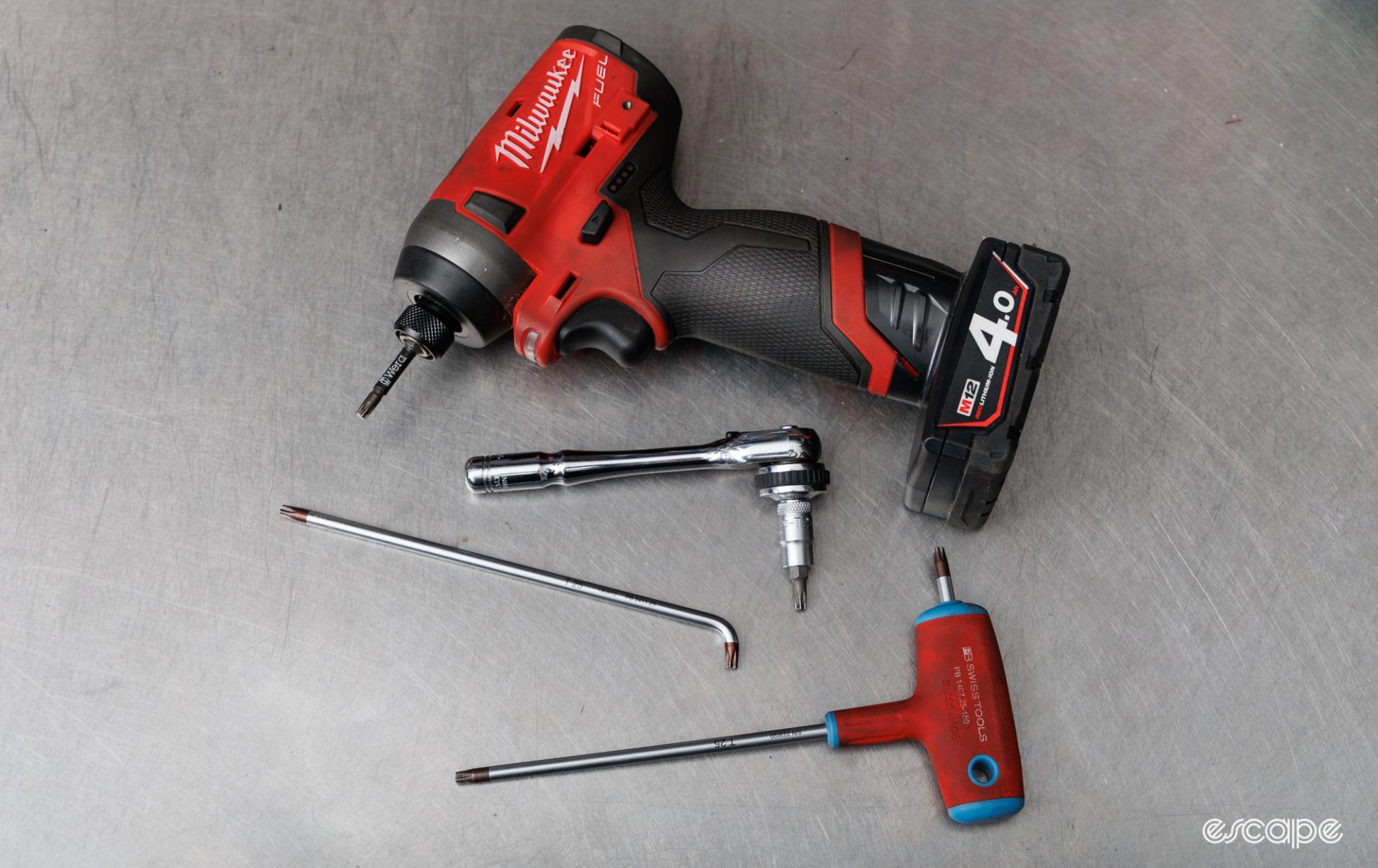
For rotor bolt installation, I’ll typically get the bolts started by hand, drive them down (carefully) with the impact driver, and then do the final tightening with either a Pedro’s preset torque tool or the PB Swiss P-handle covered above. And speaking of torque wrenches, I’ll often use whatever high-quality T25 bit is nearest and most suitable, such as the Wera Impaktor, Koken Zeal socket, or a PB Swiss TX25 C6 bit.
Those tools probably cover 98% of my T25 threading, but occasionally, I need an L-wrench for tight confines. For this, a single stubby-style PB Swiss 2411 in a T25 sits on my tool wall. It’s a tool that offers a stubby/angled end which has proven to be the perfect tool on rare T25 Campagnolo shifter body clamp bolts blocked by the shifter body.
And as a bonus tool suggestion: while I’ve rarely needed it, Wera makes specialty wedge-shaped Torx bits. The taper isn’t steep enough to do anything more for shallow button-head fastener engagement, but they can be a problem-solver for removing deeper fasteners lacking in material.
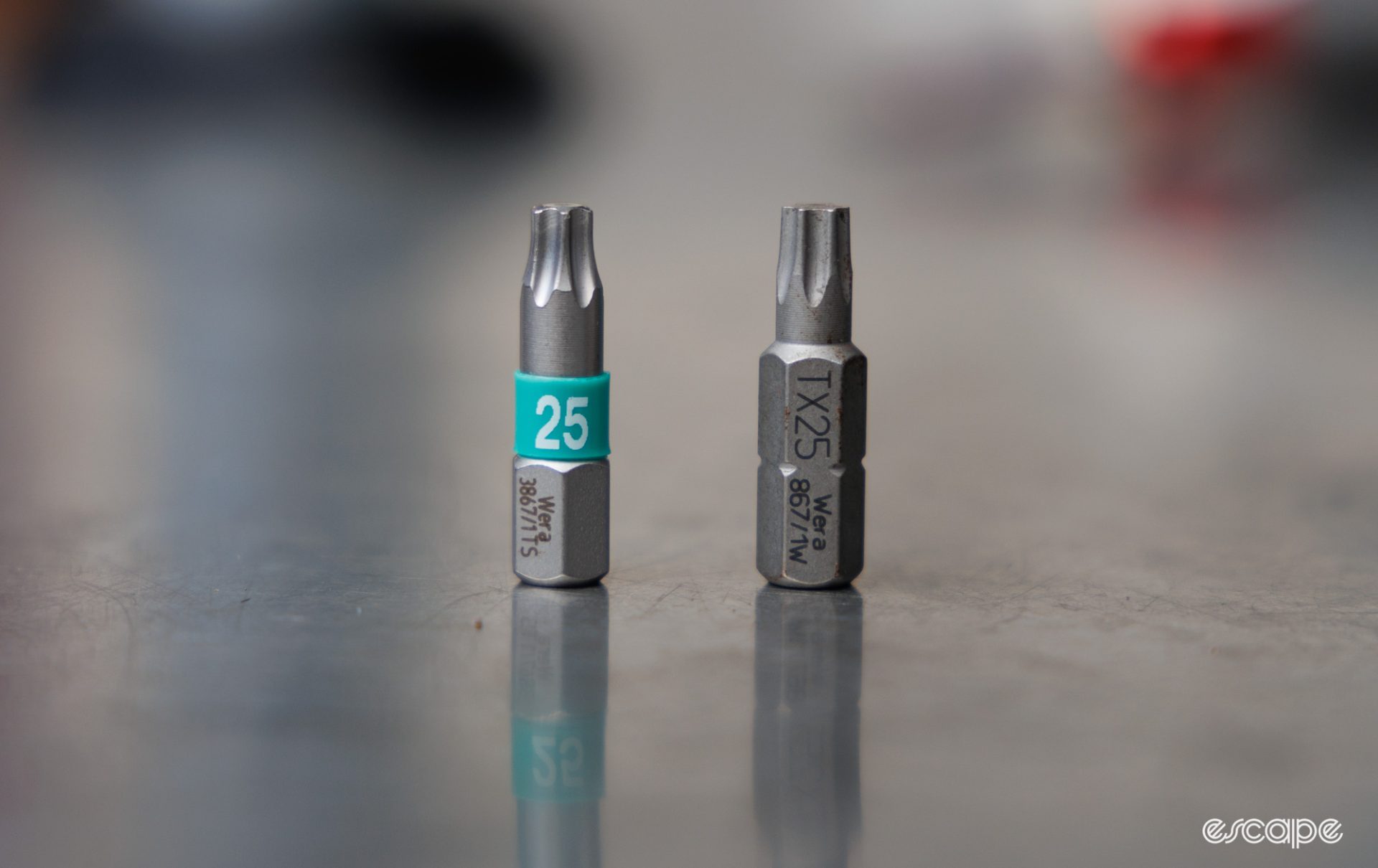
TorxPlus is coming
The world of Torx extends far beyond the simple six-sided internal variant used by SRAM, Shimano, Campagnolo, 3T, Merida, Pinarello, and countless others. Outside of cycling, other industries commonly use a tamper-proof (aka Security Torx) variant with a raised stub in the middle of the fastener head. Some automotive applications use external Torx or even five-sided Torx. And then there’s TorxPlus.
Coming from the same creators of the original Torx, TorxPlus is a successor design with wider and flatter lobes that allow for even more torque and less tool wear. Introduced in the 1990s, TorxPlus is already a widely used standard in various transport industries, however, it’s been a near non-existent sight in cycling … until now. Bosch’s latest Gen4 e-bike motors are attached to mainframes with TorxPlus IP40, and I suspect they won’t be the last to use the TorxPlus format.
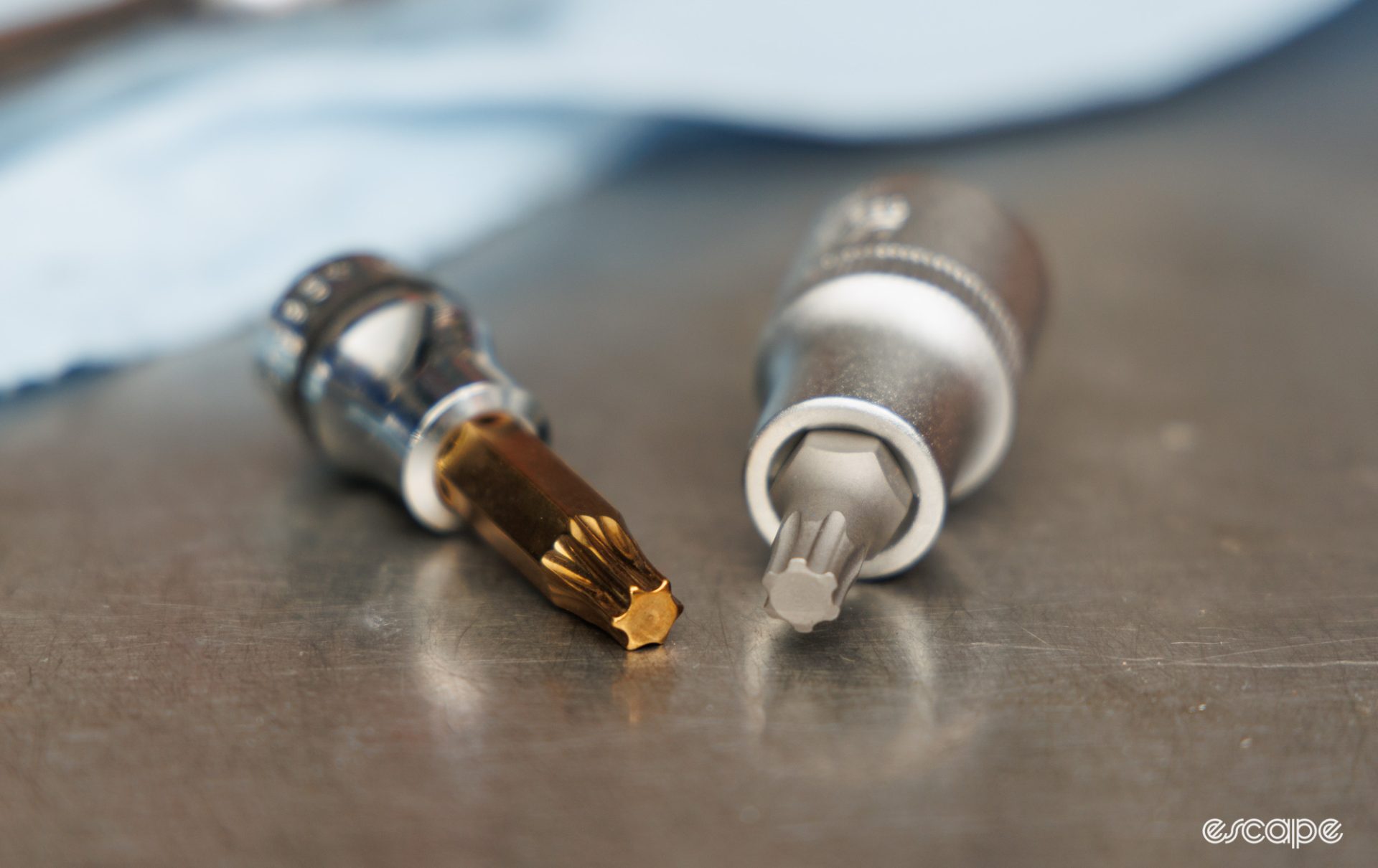
I’ve heard suggestions that an equal-size TorxPlus tool can be the perfect fit for sloppy Torx fasteners. Officially, the creators of Torx and TorxPlus say you can fit a Torx driver in a TorxPlus fastener (it’ll cam out more easily though), but not the other way around. Fundamentally if you can fit a TorxPlus driver in a Torx fastener, then you should replace the fastener.
Happier wrenching
Fewer ruined bolts can only be a good thing. If you’ve found Torx problematic to work with, then hopefully the above offers some solutions. OK, enough Torx, let me introduce you to how I’ll be doing New Tools Day moving forward
New Tools Day!
First teased at MADE, Remco Tools (not related) is soon to start shipping its great-value electric repair stand. With prices starting from US$555, the stand uses the same base bolt pattern as Park Tool’s PRS shop workstands and can be used with various popular clamp heads (the company is also working on its own). The stand only requires power to be raised or lowered, and there are three customisable preset height modes in addition to the simple up and down buttons.

I’ve been testing one of these for a few weeks, and so far, it’s been a series of highs and lows. Zing. In all seriousness, this product deserves all the attention and success it’s likely to see. It offers a comparable level of rigidity to Park Tool’s shop stands (e.g. PRS-3.3-2), but with the aid of a hands-free lift/lower for up to a 46 kg (100 lbs) load. It does, however, max out at 60 mm lower than the Park’s maximum height and there is a power cord to contend with. Expect a full review soon.
If you liked this, please subscribe to ensure you don’t miss future editions of Threaded. I’m keen to get the word out, so please share it with anyone who may find it interesting or useful. Cheers!
What did you think of this story?
